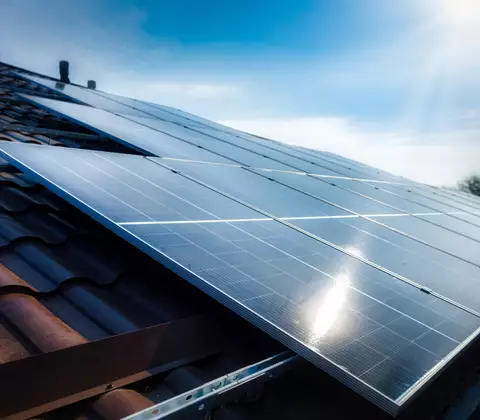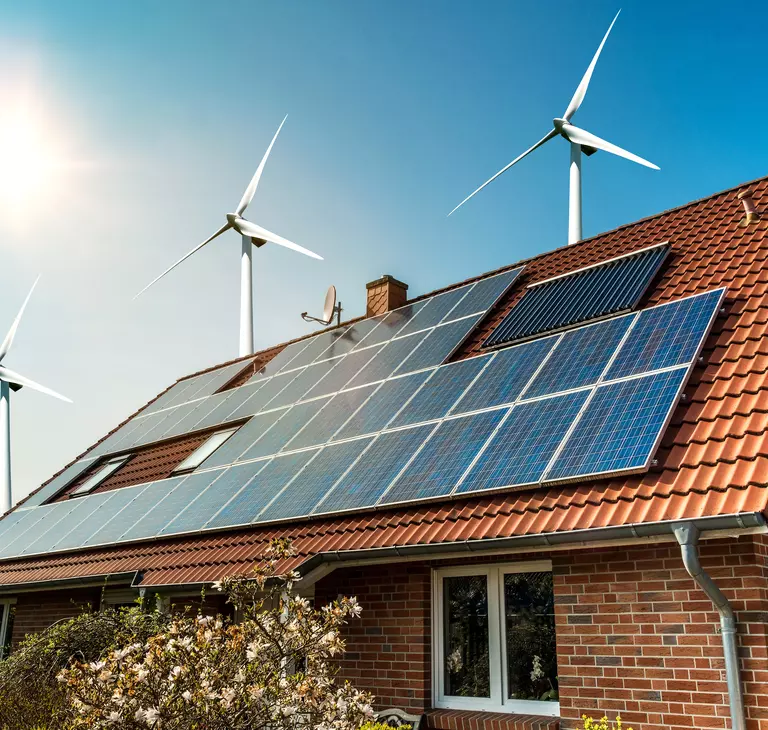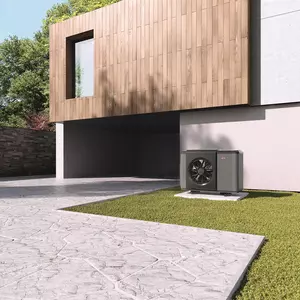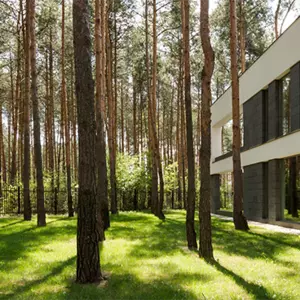
Generating your own electricity
Here’s how it works
Generating your own electricity cheaply and avoiding high electricity prices is the dream of many homeowners. And even if being completely self-sufficient is not (yet) possible in a cost-effective manner with the technology currently available, it is still possible to generate your own electricity at home. Find out below how you can best generate and store electricity yourself and what you need to bear in mind.
Why is it worthwhile?
Due to the energy transition and the phasing out of conventional forms of energy such as coal or nuclear power, renewable energies are taking centre stage. The principles that work on a large scale with wind turbines, hydroelectric power plants or solar farms can also be implemented in your own home to a certain extent. In addition, the cost of generating your own electricity has fallen due to technical advances.

01. Generating your own electricity
What are the main advantages?
Electricity from renewable energies is environment friendly, free and places no additional burden on the climate.
Generating electricity yourself reduces your dependence on local energy suppliers.
Generating your own electricity also reduces dependence on highly fluctuating electricity prices.
Generating your own electricity can also reduce your heating costs when you use modern heating systems (e.g. heat pumps).
How can you generate your own electricity?
There are countless ways to generate electricity yourself. We won’t address methods like connecting an exercise bike to a dynamo. We will focus on the main ways in which you can generate power at home in order to supplement or completely cover the electricity requirement of a detached house.
Who can generate their own power?
Most technologies are aimed at homeowners who can decide to make changes to the building in which they live. There are only a few options available for tenants, but the popularity of so-called balcony power plants (mini solar power systems) for photovoltaics is increasing. Compared to large roof-based systems, they are simple to install and operate and can cover some of the electricity needs of residential tenants.
Solar thermal systems have become popular in Germany due to government subsidies and very high feed-in tariffs in some areas. These guaranteed payments for feeding self-generated solar power into the grid also made photovoltaics a worthwhile investment.
Generating power for their own use was not formerly a priority concern for most homeowners. However, this has changed due to the increase in electricity prices and reduction in feed-in tariffs. Using the solar power yourself is now usually considered the better option from a financial perspective.
However, this involves installing energy storage systems so that the electricity you generate is available for when it is actually needed in the household.

How photovoltaics systems work at a glance
Solar cells convert sunlight into electricity. They are installed on roofs in the form of large solar modules.
The electricity you generate can either be consumed straight away or stored in a battery for later use. The electricity can also be fed into the public grid, which was commonly done in the past.
The performance of a PV system depends not only on the size of the system but also on the solar radiation at the location, i.e. the orientation of the roof and the angle of incidence of the sun's rays, among other factors. Particular attention must be paid to keeping the solar modules clear from shade, as the angle of the sunlight will change over the course of the year. Modern solar cells can now generate a relatively large amount of electricity even if the angle of incidence is relatively unfavourable (e.g. on the façade) and in diffuse light conditions.
How big does your photovoltaic system need to be?
The size of the system depends on your household's annual electricity requirements. A four person household consumes around 5,000 kilowatt hours (kWh) per year on average, for which a PV system should generate around 4 to 6 kWp (kilowatt peak). Between eight and ten square metres of space are required per kilowatt peak of power. However, this value can vary depending on the location and the technology used in the solar modules.
Experts recommend making sure that your PV system is large enough. Economically speaking, a higher output is better, as the relative price per kilowatt of generated power increases when using smaller solar thermal systems. You can use battery storage for surplus electricity. Another alternative would be to use the electricity from the PV system in conjunction with a heat pump. These can temporarily store unneeded heating energy in a buffer cylinder for hot water and/or central heating backup.

Top advice from WOLF
If you are looking for an efficient heat pump for your existing building or a new build, you should seek in-depth advice. Correct dimensioning and careful planning are crucial for efficient heating. The experts at WOLF will be happy to help you.
Large wind turbines are very efficient in suitable locations. However, small systems are less suitable for generating electricity for your own use, as the energy yield depends on the installed height, among other factors. Permits are not granted for these systems in densely built-up areas. You also need to consider the costs and space requirements for sufficiently large battery storage systems so that you can make the best possible use of the electricity you generate. Feeding wind energy into public grids is also a less attractive proposition than it used to be.
A combined heat and power unit is a combustion engine that generates electricity as a by-product in addition to heating energy for the house. This design is considered a renewable option due to its high level of efficiency - surplus heat is not lost as it is when using traditional oil heating systems. Systems of this kind are usually found in larger buildings. Combined heat and power units for homes that can generate heat and electricity themselves are comparatively expensive. In return, they supply energy on demand, and not only when the sun is shining or the wind is blowing.
Anyone who wants to generate electricity themselves must comply with certain obligations depending on the technology involved. Even though renewable energies are available free of charge, costs and possibly taxes are incurred for the purchase and maintenance of the system. We also strongly recommend insuring your expensive investment.
Find an installer now!
Find competent WOLF heating engineers in your area.
Obligations of operators of photovoltaic systems
Homeowners with a photovoltaic system that is connected to the electricity grid must register it with the Federal Network Agency and the responsible grid operator. This is also required in order to be able to claim the feed-in tariff. Registering with the tax office is also necessary. Anyone who generates their own electricity with a roof-based photovoltaic system is considered an entrepreneur by the tax office, even if it is not mandatory to register a business. The amount of tax due depends on whether you are a small business or a business subject to VAT.
Value-added tax is always due If a turnover of more than EUR 22,000 per year is achieved. This applies regardless of whether the electricity is consumed by the owner or fed into the grid. Sales and VAT of 19% are calculated on the basis of current electricity prices and the amount of electricity generated in kWh. Small business owners, on the other hand, don’t have to pay VAT on the electricity generated, but only on the installation of the solar thermal system. Entrepreneurs subject to VAT can deduct the acquisition costs from their taxes.
A photovoltaic system is an efficient way to generate your own electricity. Wind power and combined heat & power plants are not a relevant or even feasible option for most homeowners. Feeding energy into the public grid is no longer really worthwhile due to the reduced rates offered. Energy generation for own use should therefore be the main focus. Suitable power storage units or connection to other energy storage units (e.g. buffer cylinder of the heating system for DHW heating) are strongly recommended. The WOLF hotline will be happy to advise you on the different intelligent power generation options in combination with modern heating systems.


